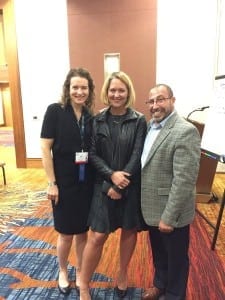
Thought leadership: It may be on your C-suite's wish list, but like many PR goals, the buzz phrase needs to be broken down into executable tactics in order to be both meaningful and achievable.
On Oct. 23 at the PRSA International Conference in Indianapolis, David Siroty, vice president of North American communications, Coldwell Banker Real Estate, and Lindsey Turrentine, editor-in-chief, CNET.com, broke down their own tactics as they spoke about the fruitful strategic partnership their brands have worked toward in the last decade. Anne Green, president and CEO, CooperKatz & Company (Coldwell is her client), moderated the session.
At the core of CNET and Coldwell's partnership is a mutual interest around sparking consumer interest in "smart homes"—homes that are optimized for a wide range of devices that run on Wi-Fi or Bluetooth networks. Siroty, Turrentine and Green spoke with PR News at the PRSA Conference about the origins and evolution of the partnership, and offered advice for communicators seeking to build relationships with the media and other brands to drive true thought leadership.

PR News: How did the idea for the current partnership between CNET and Coldwell come about?
David Siroty: It started with looking at the home as an emotional center of our lives, not just a [financial] investment. We educated our agents and took advantage of this white space: No one [in the real estate industry] was going toward smart homes. That led us to start thinking about partnerships; we went to CES [Consumer Electronics Show, an annual trade show] on a fact-finding mission, where the fiancee of one of our employees met Lindsey, and said, "They're great—you should give them a call."
Lindsey Turrentine: We saw a partnership with Coldwell as an opportunity to educate their agents and a potential way to bring knowledge and excitement around the smart home to a very broad set of consumers that may not have [previously] heard about that technology through CNET.
PR News: What are a few ways communicators can start their own media partnership programs?
Anne Green: The first is to think of thought leadership in a deeper way. If you're going to make a meaningful partnership strategy, you have to ask yourself first: What's the goal, what's the audience, what's the business objective?
But also: Is there white space? Is there something that's more thought leading, as in bringing a new way of looking at something, discovering something—that you can do, with others, to bring together more knowledge and reach audiences in a new way?
Second, don't start with the checkbook or media buying agency or lawyers with a contract. Start with a conversation and build a relationship. Walk before you run, thinking about who the adjacencies are, [rather than] direct competitors. Who's like-minded, who will complement what you're doing? And then have a conversation: "You're interested in this, we are [too]; here's what we're thinking. This is our hypothesis. What can we do together?"
Third, be very open to allowing [the partnership] to be organic in its evolution. There are going to be fits and starts.
PR News: What are the qualities you look for in a media partner? What are some tactics communicators can use to find a good match?
Siroty: While trying to get our content out there, [we asked]: Can we really do it ourselves? No. Can we get others to help? Yes. But no one has enough money to buy their way in everywhere. We looked for personalities that get along.
Turrentine: For us, because we are a content company, we are looking for ways to get our content out there. It's a chance to do what we do well in front of people who may not have met us before.
PR News: What are the biggest roadblocks communicators can encounter while attempting to pursue these types of partnerships?
Green: You have to put ego aside because internally the fight of who owns what can be a challenge. If there's no immediate ROI, financial [stakeholders] might think, "What is this?" And legal [departments] might feel uncomfortable without formal letters of intent. You have to be willing to be patient if it's something your company has never done before.
PR News: What are some metrics you can use to prove ROI to senior leadership in pursuing these relationships?
Green: Bring all the evidence to bear you can, qualitative and quantitative. In this case, the quantitative was the projected growth of the smart home market—a lot of which came from Lindsey and CNET—and research we did among agents and consumers. Agents start hearing their buyers and sellers talk about smart homes; consumers expect their agents to be able to talk about technology in the home. Then you get some advocates in your key audiences—in [Coldwell's] case, the buyers and agents—saying "I see value in this."
PR News: What do you do when you work with a partner who doesn’t deliver, when the relationship becomes one-sided?
Turrentine: Instead of saying, "This isn't working for us," I say, "Here's what I need. These are my interests, and here's what I'm able to bring to the table."
Siroty: And it wasn't hard, because we became friends and colleagues, so when there was something that came up—like a second survey Coldwell asked for that CNET didn't have bandwidth for at the time—we'd just say "Are you OK if we go somewhere else?" And they'd say, "Sure, do you need help finding someone else?"
Green: There were players we tried to work with, but they weren't that committed, so we just let them fade away. When you use this kind of strategy, where it's not just a money exchange, you can't force it. If somebody's resistant, you start to let it fade away.
PR News: What do you see as the next major trends in brand partnerships and thought leadership in 2017?
Siroty: I think [partnerships] are everything. Look at AT&T and Time Warner. How can those two compete? They need each other! For just about every brand trying to reach consumers, it's probably going to be having other brands help you on the social side.
Turrentine: In terms of thought leadership, as long as communicators continue to find creative ways to bring new information to audiences who don't know it, they will continue to bring value for themselves and the brands they represent. And it seems simple, but you have to meet new audiences to bring new thoughts to audiences. It's essential to be thinking about white spaces. For us the world of real estate was one of those white spaces.
Green: The content marketing area is likely to become more and more difficult, as everybody wants to create content, yet [maintain] the best practices of [keeping content] interesting and relevant. There's a lot of stuff being pumped out there, and not all of it is engaging. The marketing industry has been very fixated on native advertising, content marketing, owned channels, paid social, owned social, which is all very important. But it's going to be harder and harder for brands to break through if we don't pay attention to what's actually thought leading.
Follow David:@dsiroty
Follow Lindsey: @lturrentine
Follow Anne: @anneegreen
Follow Sophie: @sophiemaerowitz
